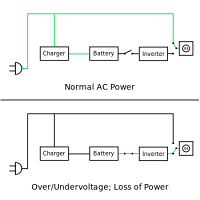Most of us know that an uninterruptible power supply acts as a back-up power for devices such as computers and so on. They are the ones responsible for the safety of our information being saved just in time a power failure occurs. It supplies sufficient power to save your files and shutdown your computer in the right manner to avoid future damages on your device.
But from what we already know, did you know there are three (3) categories of uninterruptible power supply these are:
- Standby (offline)
- Online
- Line-Interactive
Here’s its definition:
1. STANDBY/OFFLINE UPS
 |
| Source: Wikipedia |
It is the cheapest among the 3 categories for it only offers basic features, providing surge protection and battery backup. When the standby UPS determines the voltage falls below or rise above the predetermined level it then turns on its DC-AC inverter circuitry, wherein the power comes from the internal storage battery. From the switchover time that can last as long as 25 milliseconds with regards to the detection of lost utility voltage, the UPS then mechanically switches the connected equipment on to its DC-AC inverter output.
This UPS was designed to power certain equipment such as personal computer but could not handle objectionable dip or brownout to the device. This was not considered as “uninterruptible” due to its switch time (usually under 5 ms, 25 ms but sometimes as long as 100 ms) and its momentary switch lapse.
2. ONLINE UPS
This might be the most expensive among the three but it guarantees you of quality service it could provide.
Back in the day, this kind of UPS was not widely introduced due to its expensiveness but recent technology made it possible to be affordable by many. Though still cost a fortune if you sum up all your expenses upon not buying such kind would be just equal the cost.
This UPS runs in a double-conversion method, wherein it takes AC power from the wall and converts it to DC to charge the battery. Then takes the DC power from the battery and converts back to AC, which can be used in computers.
Why it cost more than the others is due to it having a much greater current AC-to-DC battery-charger/rectifier and with the rectifier, an electrical device responsible for converting alternating current (AC) to direct current (DC), which flows in only one direction, and inverter designed to run continuously with improved cooling system.
A similar yet another online method was the delta conversion, where the portion of the power was delivered directly to the computer, rather than through the battery.
Its difference from a standby UPS was it continuously filters power through the battery before sending it to your computer rather than it being engage only when the problem occurs. It’s like early detection even before the problem arises.
3. LINE-INTERACTIVE UPS
A line-interactive UPS could handle brownouts but in a considerable price, from it having a special type of transformer which varies the output voltage in response to momentary power fluctuations.
The special type of transformer can add or subtract powered coils of wire, wherein it increases or decreases the magnetic field and the output voltage of the transformer. This was also known as Buck-boost transformer.
This UPS could withstand undervoltage brownouts, a momentary power sag, and overvoltage surges without needing the limited the reserved battery power. It then automatically select different power taps on the transformer that causes the power-loss alarm to “chirp” for a moment.
For uninterruptible power supply needs just visit - Panther ph, an electrical supplier promises to serve you the best you deserve.




No comments:
Post a Comment